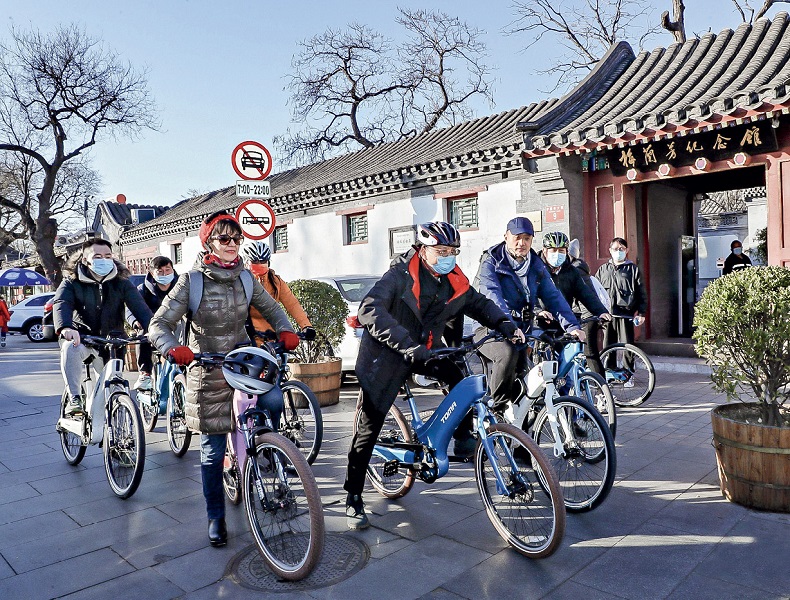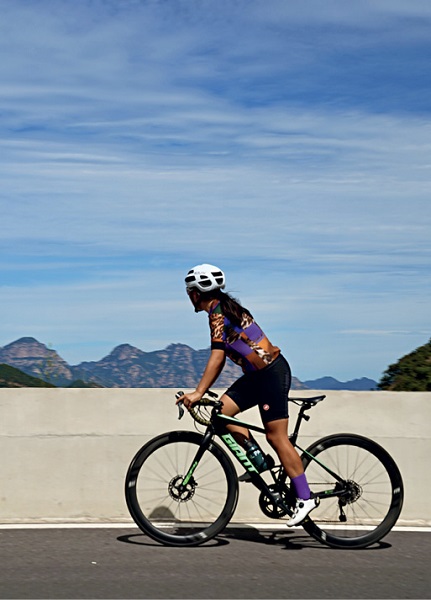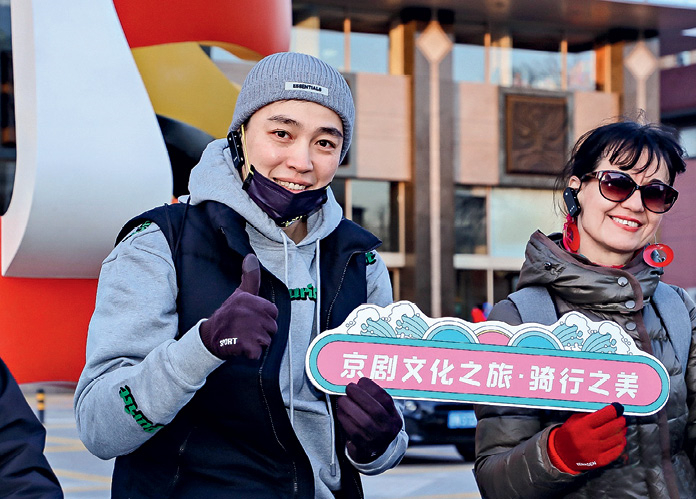Experiencing the Beijing Charm on Two Wheels
“I’ve ridden through the beautiful and spacious New Shougang Bridge over a hundred times!” exclaimed cycling enthusiast Xiao Er at the bridge, which has become one of the most popular spots for cyclists in Beijing in recent years.
Nowadays many people have switched leisure and fitness activities from indoor to outdoors – with cycling once again becoming popular. A growing number of cycling enthusiasts ride through the sprawling streets and alleys to feel and embrace the charm of the ancient capital.

Chinese and foreign cyclists visit Mei Lanfang Memorial Hall and feel the unique atmosphere of Beijing on December 2, 2022.
Health Consciousness in Vogue Again
Xiao shared the pictures of her bike riding activity on Xiaohongshu, a platform that inspires people to discover and connect with a range of diverse lifestyles. “After riding, I have become more energetic and stronger, and it has also made me sunnier and more confident,” Xiao shared joyfully, garnering many likes on the platform.
As a veteran cycling enthusiast, over the past two years, Xiao has been fascinated by road cycling and the exploration of Beijing’s urban spaces. “I didn’t want to go to places more than 10 kilometers away, but now with a mountain bike, places even 100 kilometers away are all within consideration,” Xiao said proudly.
“Last summer, I spent more than five hours riding along the Baihe Gorge, which is about 120 kilometers long, and climbed 2,000 meters.” Xiao was thrilled to be able to ride all the way north, through Beijing’s heavy traffic, and ride in the beautiful scenery. “This is the land of idyllic beauty in my heart, with mountains and streams, beautiful scenery – a place I have never set foot in before.”
Xiao has also explored Beijing’s hutongs many times. “Recently I rode around Huafeng Hutong and Liuli Hutong. The Spring Festival atmosphere was rich, and there were many lanterns, New Year scrolls, and the characters for ‘fortune’ on the gray wall in hutongs, which is festive and beautiful.” Cycling through the streets, Xiao casually photographed people shopping and enjoying themselves at specialty cafés, and captured Beijing’s lively hustle and bustle.
She was delighted by countless new discoveries along the way: “Thanks to riding! It gave me a better understanding of the city.”
In Beijing, there are many people who love cycling just as much as Xiao. According to statistics, from January to August 2022, the cumulative number of cycling trips in Beijing reached 638 million. The increasingly popular concept of green travel and the renewed emphasis on health brought about by the pandemic have boosted cycling’s return to the city.
“People choose more outdoor activities, and improving health through cycling is also a green way to travel, and the connotation of cycling is gradually expanding. Cycling is also a fashion, a type of communication, an exploration, appreciation, and blending into the city,” said Feng Baozhong, vice chairman of the Chinese Cycling Association.

Xiao Er is cycling in Beijing’s western district of Mentougou.
People-oriented Slow-traffic System
Beijing’s first designated bike lane opened in May 2019, connecting Huilongguan Community in Changping District, known for its affordable housing, with the Shangdi area of Haidian District, where many large technology companies are located. According to statistics in May 2021, the cumulative traffic volume of this bicycle lane exceeded 3.18 million cyclists, and the cumulative carbon emission reduction has exceeded 800 tons.
Starting from 2021, many intersections on Guangqu Road have installed separate signals for cars and bikes. Cyclists only need to wait once for a green light to make a left turn, whereas previously cyclists needed to wheel the bicycle at the crosswalk and wait twice for the signal to fully cross the intersection.
Furthermore, roadside parking spaces in Beijing’s Central Business District (CBD) have been almost entirely removed, parking surveillance cameras are also watching every street and alley in real time, to reduce vehicles parking in the bike lane. This allows bicycles to pass smoothly through the CBD area.
In recent years, Beijing has been improving its cycling environment by upgrading its slow-moving traffic system.
In the past, on the days when use of his car was restricted based on the last digit of license plates, Li Xiang, an office worker in Beijing, took the subway to work. Since 2021, he rides to work in 30 minutes from Shuangjing to Dongdan when the weather is good. In recent years, Beijing has improved the city’s cycling environment by cleaning up the slow traffic system, enticing him to ride out more. Without the interference of cars and electric bicycles, traffic safety of the bike lanes is enhanced.
Beijing has also built a number of urban parks for cycling. There is a comprehensive walking and cycling path in Grand Canal Forest Park in Tongzhou District, where cyclists can enjoy the riverside scenery. In addition, many cyclists have found that there are also bicycle paths built along rivers and some small street parks that were previously only walkable.
In the future, Beijing will continue to promote the transformation and upgrading of the slow-traffic system, and there will be more and more places for cycling. During the 14th Five-Year Plan period (2021-2025), all roads with a width of 12 meters or more within Beijing’s Fifth Ring Road will be equipped with bicycle lanes, and a 396.8-kilometer waterfront slow-traffic system will be built.
By implementing the transportation development concept that gives priority to slow traffic, public transportation, and green travel, Beijing will allow its citizens to feel at ease when cycling and walking.

Chinese and foreign cyclists enjoy the charm of riding through Beijing and learning about Peking Opera.
Cycling and Cultural Events
In 2022, the Beijing Municipal Bureau of Culture and Tourism unveiled 21 cycling routes across the city to promote cultural tourism and bolster consumption. The total distance traversable across the 21 routes is about 730.8 kilometers. Among them, four are cross-district routes that pass through the city’s revolutionary sites or Central Axis and another 17 reflect the respective features of each district in Beijing.
As a first, these cycling routes offer a compelling fusion of cycling with cultural experiences, as well as entertainment activities and innovative solutions for cultural tourism consumption, satisfying cyclists’ needs for short and medium-distance cultural tourism.
In November 2022, a group of overseas students from more than 10 countries and regions who were studying in Beijing Jiaotong University rode along the Central Axis to understand the history and culture, feeling the profundity of the embedded history and atmosphere of vigorous development, and experienced the extensive and rich heritage of the Chinese civilization.
During the 2022 China International Fair for Trade in Services, cycling routes were planned around Shougang Park and the birthplace of Peking Opera. The whole process was broadcasted live, promoting national fitness and green travel, carrying forward the spirit of the Beijing Winter Olympics, and arousing widespread excitement.
Famed Peking Opera artist Hu Wenge participated in the cycling and talked about the inheritance and development of Peking Opera, and also performed at the site of the No.3 Blast Furnace again after Peking Opera maestro Mei Lanfang performed The Drunken Concubine at Shougang in 1959, reproducing the beauty of the Mei School and paying tribute to Mei Lanfang.
The ancient capital unfolds its scenery for cyclists, and cyclists are constantly exploring more mysteries of the city.
blog comments powered by